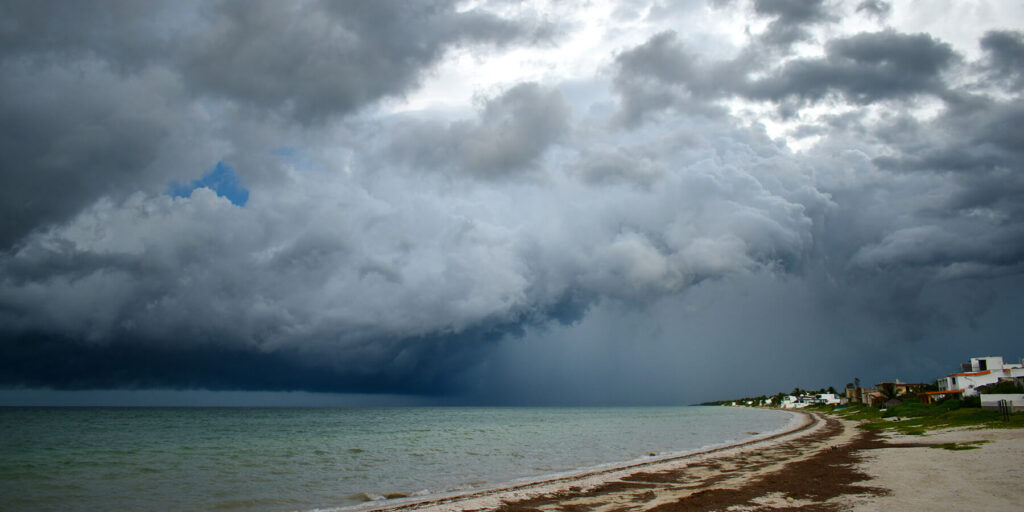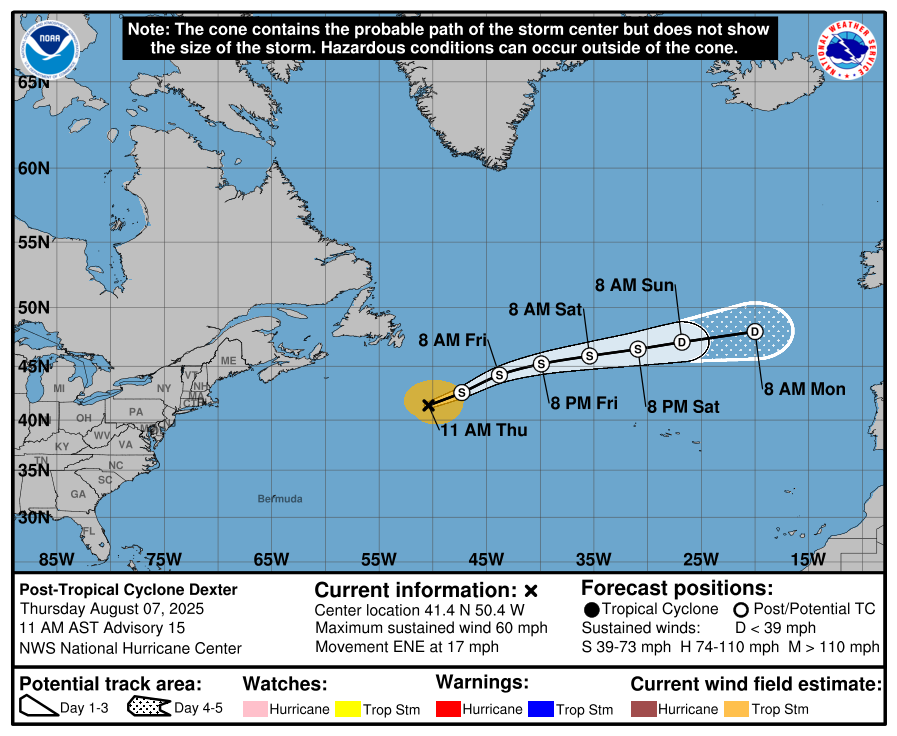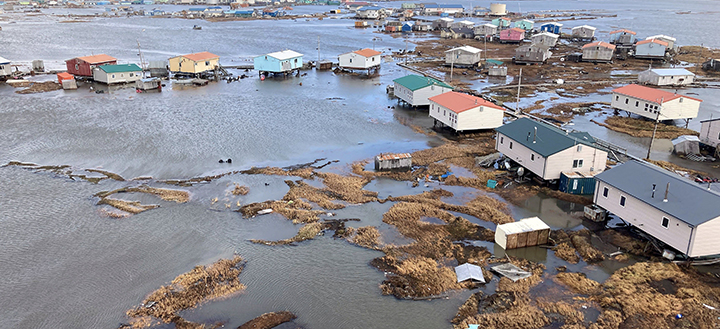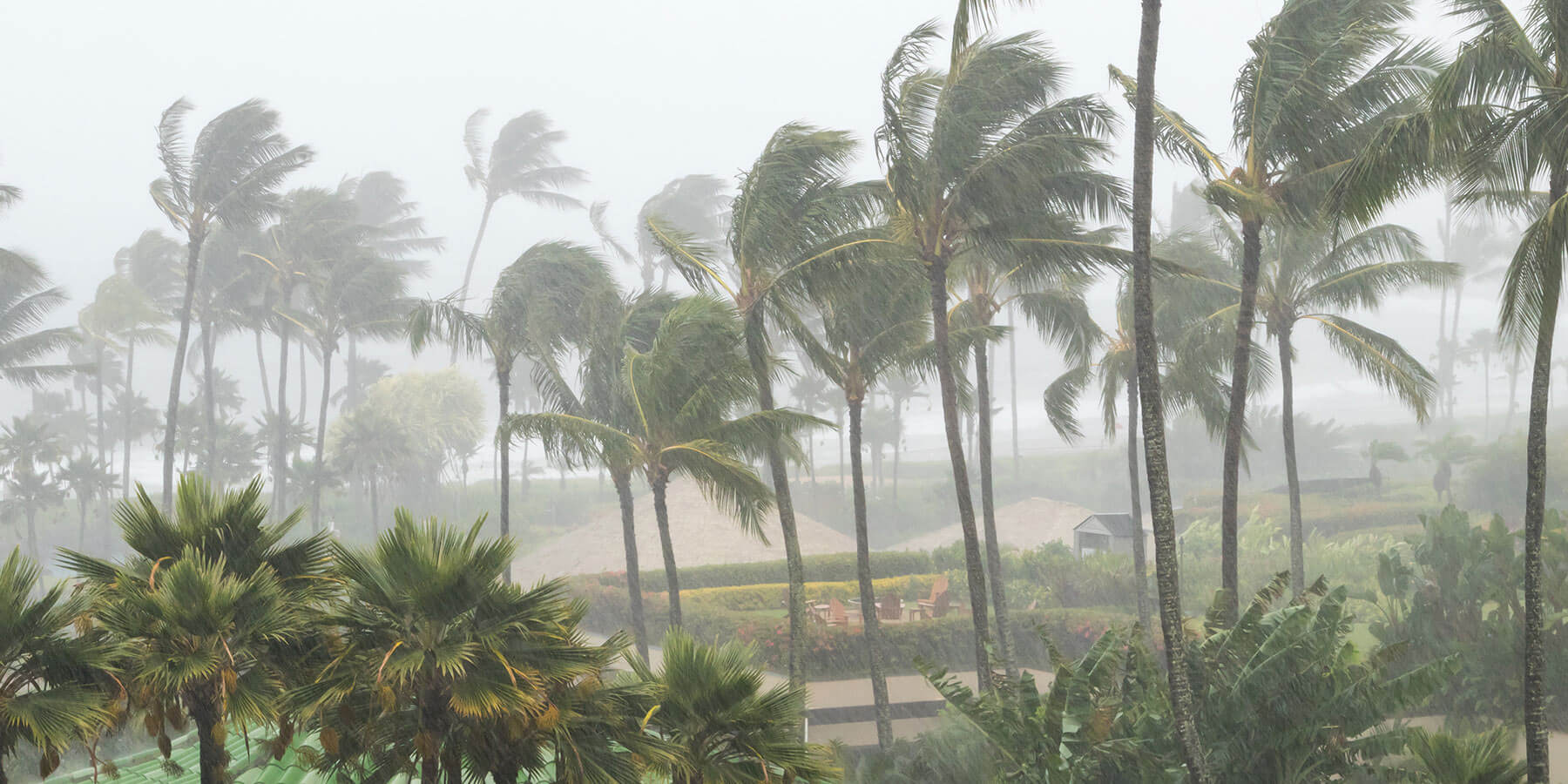Updates
Updated 08/07/2025
- Dates Active: August 4 to August 7, 2025
- Peak Strength: Tropical Storm with 1002 millibars
- Maximum Sustained Winds: 40-45 mph winds
- Path: Moved northeast in the Atlantic Ocean
- Significant Impact: None
Tropical Storm Dexter, and if it strengthens, Hurricane Dexter, are names to know as we look to its development during the 2025 Atlantic Hurricane Season.
Now, the name Dexter can be crossed off the official list of storm names provided by the World Meteorological Organization (WMO) for 2025.
This article explores the formation of Tropical Storm Dexter, the science behind tropical systems, and how individuals, organizations, and local governments can prepare for the potential impacts.
The Origins of Tropical Storm Names
The practice of naming tropical storms began to simplify communication and increase public awareness during severe weather.
The WMO oversees the naming system, maintaining annual rotating lists of male and female names used for each ocean basin.
For the Atlantic Basin, storm names are selected to be culturally relevant, easy to pronounce, and recognizable across languages. This helps communities and emergency services discuss and respond to a storm with clarity and consistency.
The History Behind the Name Dexter
The name Dexter has Latin origins, meaning “right-handed” or “skillful.” It gained popularity over the years as a masculine name and has been commonly used in English-speaking countries.
Other Notable Storms Named Dexter
The name Dexter is making its debut on the Atlantic hurricane name list in 2025 as a replacement for Dorian which was retired after the devastating 2019 hurricane.
While Dexter has not been used for tropical cyclones in any other region, similar-sounding names such as Darian have appeared in other basins like the Australian region.
However, there are no notable storms named “Dexter” in other parts of the world, making its upcoming use in the Atlantic a first.
Could Tropical Storm Dexter Become Hurricane Dexter?
With Tropical Storm Dexter formed, whether it intensifies into a hurricane will depend on several environmental factors.
For a tropical cyclone to form and strengthen, the following elements must align:
Sea Surface Temperatures (SSTs)
Tropical cyclones require warm waters to fuel them, typically with SSTs exceeding 80°F (26.5°C).
The National Oceanic and Atmospheric Administration (NOAA) reports above-average SSTs in sections of the Atlantic, especially in the tropical storm development zones.
These warm waters, combined with conducive atmospheric conditions, could create an ideal environment for Dexter to intensify from a tropical storm to a hurricane.
Low Wind Shear
Minimal wind shear is necessary for a tropical cyclone to organize and grow. Strong vertical wind shear can disrupt a storm’s structure, preventing it from strengthening into a hurricane.
Moist Atmosphere
Hurricanes require high levels of atmospheric moisture. Dry air aloft inhibits storm growth, whereas a moisture-rich atmosphere drives the developmental processes of storms like Dexter.
Atmospheric Instability
Warm rising air clashing with cooler descending air creates the unstable conditions necessary for cyclonic activity to thrive.
Pre-Existing Disturbance
Storms typically form when small clusters of thunderstorms or tropical waves undergo intensification. Keep a close eye on localized disturbances across the Atlantic, as they could serve as precursors to Tropical Storm Dexter.
Preparing for Tropical Storm or Hurricane Dexter
Whether or not Dexter grows into a hurricane, preparation is essential. Here’s a guide to help individuals, families, and organizations brace for potential impacts.
Individuals and Families
- Prepare Emergency Kits: Stock up on non-perishable food, bottled water, medications, flashlights, batteries, and essential documents. Include a weather radio for real-time alerts.
- Review Evacuation Plans: Know your designated evacuation zones and map routes to local shelters.
- Secure Your Home: Board up windows, trim tree branches, and bring outdoor items inside to prevent damage from high winds.
- Stay Updated: Follow trusted news outlets, the National Hurricane Center (NHC), and local government announcements for timely developments regarding Dexter.
Business Owners and Organizations
- Safeguard Critical Assets: Protect important documents, computer systems, and physical inventory that may be affected by high winds or flooding.
- Employee Communication: Distribute clear emergency plans, including remote work protocols or temporary closures.
- Business Continuity Planning: Develop plans to maintain operations through potential disruptions, ensuring minimal impact on clients and customers.
- Collaborate Locally: Coordinate with local emergency services to remain aligned with broader response efforts.
Local Governments and Municipalities
- Public Communication: Disseminate clear, accurate information about preparedness plans and evacuation zones.
- Infrastructure Resilience: Identify vulnerable areas and prioritize securing critical infrastructure, such as hospitals, schools, and water systems.
- First Responders: Ensure emergency teams are staffed, equipped, and ready to assist communities in the event of disaster.
Learning from Recent Hurricane Seasons
Recent hurricane seasons show us the need for vigilance and preparation. The record-breaking 2020 Atlantic Hurricane Season saw 30 named storms, the most on record.
In 2022, Hurricane Ian devastated areas of Florida with more than $113 billion in damages. And in 2024, Florida was hit back-to-back with Hurricane Milton and Hurricane Helene, which brought historic levels of wind and flooding.
These examples provide key takeaways for why we must be proactive in our preparedness and pay attention to potential storms like Dexter.
Staying Updated on Tropical Storm and Hurricane Dexter
Reliable information is important when preparing for tropical storms and hurricanes. Stay informed using these trusted resources:
- National Hurricane Center (NHC)
- National Oceanic and Atmospheric Administration (NOAA)
- Local Meteorological Services
Whether or not Dexter forms in the coming months, prioritizing preparedness is the best way to ensure safety and minimize potential damage.
Want more information on hurricane season and preparedness? Take a look at our Hurricane Resource Center for free community materials and resources.
We also recommend checking out our in-depth article on interesting facts about hurricanes.
Frequently Asked Questions About Tropical Storm/Hurricane Dexter
Has Tropical Storm Dexter formed yet?
Yes, Tropical Storm Dexter has formed and is the 4th name on the World Meteorological Organization’s list for the 2025 Atlantic Hurricane Season.
How does a tropical storm’s name get chosen?
The WMO maintains and rotates lists of names used for tropical systems. Names are selected to be easy to pronounce and recognized globally.
What is the difference between a tropical storm and a hurricane?
A tropical storm has wind speeds of 39-73 mph, while a hurricane features winds of 74 mph or higher. Strength depends on factors like wind shear, sea surface temperatures, and atmospheric conditions.
Where should I look for updates on Dexter’s potential formation?
Follow updates from the National Hurricane Center (NHC), NOAA, and your local meteorological services.
How can I prepare now for Dexter and other storms?
Start by preparing an emergency kit, securing your home, and having a clear evacuation plan. If you’re a business owner, develop a business continuity plan and coordinate with local officials.
What time of year is most active for tropical storms?
The Atlantic Hurricane Season runs from June 1 to November 30, with the peak typically occurring between August and October.
Can tropical storms rapidly intensify into hurricanes?
Yes, under favorable conditions like warm sea temperatures and low wind shear, tropical storms can quickly strengthen into hurricanes.
How are tropical storms monitored?
Meteorologists use satellites, weather buoys, aircraft reconnaissance, and radar systems to track and predict tropical storm development and movement.
What makes a tropical storm dangerous even if it’s not a hurricane?
Tropical storms can bring heavy rainfall, flooding, strong winds, and storm surge, all of which can cause significant damage and pose safety risks.
Are tropical storm names ever retired?
Yes, if a tropical storm or hurricane causes significant damage or loss of life, its name may be retired and replaced by the WMO to avoid future confusion or sensitivity.




